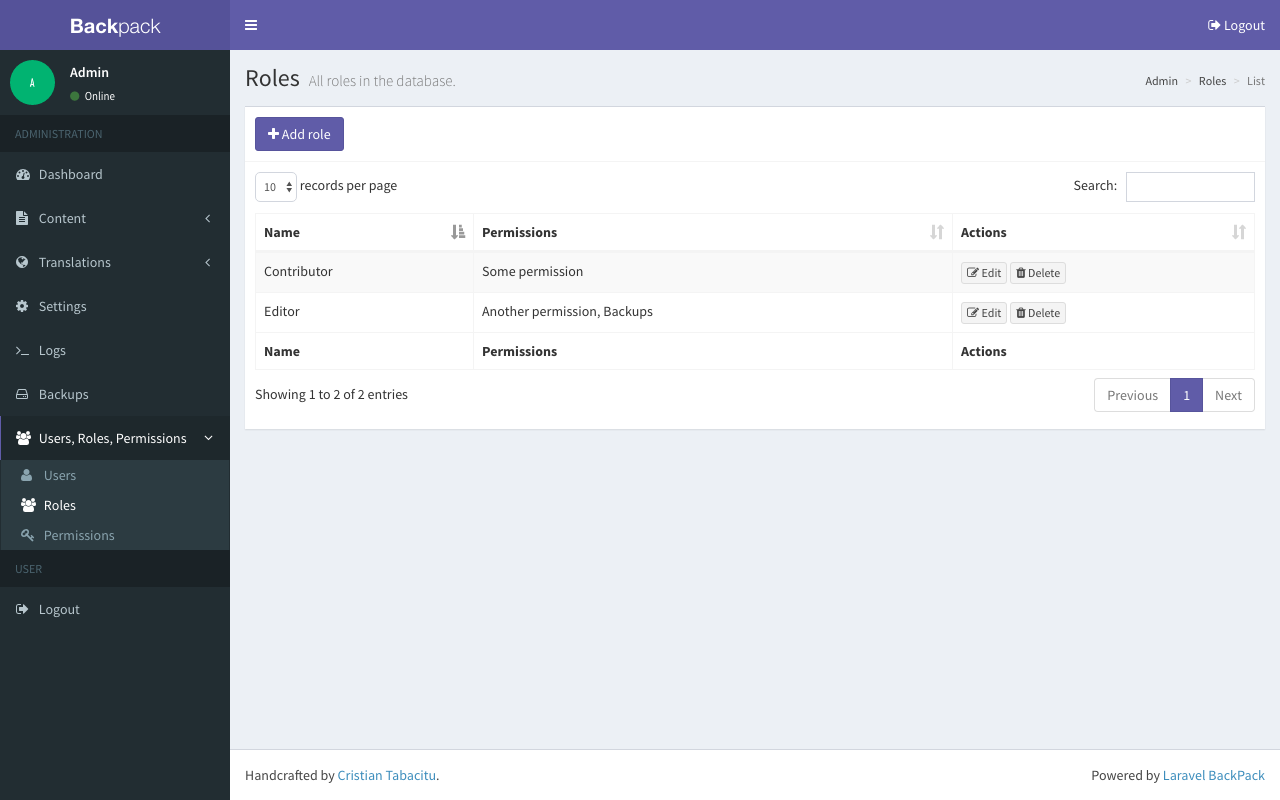| Package Data | |
|---|---|
| Maintainer Username: | tabacitu |
| Maintainer Contact: | marius@updivision.com (Marius Constantin) |
| Package Create Date: | 2016-05-13 |
| Package Last Update: | 2025-11-19 |
| Home Page: | http://backpackforlaravel.com |
| Language: | PHP |
| License: | proprietary |
| Last Refreshed: | 2025-12-10 03:19:45 |
| Package Statistics | |
|---|---|
| Total Downloads: | 1,672,808 |
| Monthly Downloads: | 31,017 |
| Daily Downloads: | 1,291 |
| Total Stars: | 550 |
| Total Watchers: | 28 |
| Total Forks: | 165 |
| Total Open Issues: | 1 |
Admin interface for spatie/laravel-permission. It allows admins to easily add/edit/remove users, roles and permissions, using Laravel Backpack.
As opposed to some other packages:
This package is just a user interface for spatie/laravel-permission. It will install it, and let you use its API in code. Please refer to their README for more information on how to use in code.

Security updates and breaking changes
Please subscribe to the Backpack Newsletter so you can find out about any security updates, breaking changes or major features. We send an email every 1-2 months.
This package assumes you've already installed Backpack for Laravel. If you haven't, please install Backpack first.
In your terminal:
composer require backpack/permissionmanager
php artisan vendor:publish --provider="Spatie\Permission\PermissionServiceProvider" --tag="migrations"
php artisan migrate
php artisan vendor:publish --provider="Spatie\Permission\PermissionServiceProvider" --tag="config"
// then First, add the Spatie\Permission\Traits\HasRoles trait to your User model(s)
php artisan vendor:publish --provider="Backpack\PermissionManager\PermissionManagerServiceProvider"
App\Models\BackpackUser to administer Users. Use a different one if you'd like by changing the user model in the config/backpack/permissionmanager.php file. Any model you're using, make sure it's using the CrudTrait and HasRoles traits:<?php namespace App;
use Backpack\CRUD\CrudTrait; // <------------------------------- this one
use Spatie\Permission\Traits\HasRoles;// <---------------------- and this one
use Illuminate\Foundation\Auth\User as Authenticatable;
class User extends Authenticatable
{
use CrudTrait; // <----- this
use HasRoles; // <------ and this
/**
* Your User Model content
*/
resources/views/vendor/backpack/base/inc/sidebar_content.blade.php or menu.blade.php:<!-- Users, Roles Permissions -->
<li class="treeview">
<a href="#"><i class="fa fa-group"></i> <span>Users, Roles, Permissions</span> <i class="fa fa-angle-left pull-right"></i></a>
<ul class="treeview-menu">
<li><a href="{{ backpack_url('user') }}"><i class="fa fa-user"></i> <span>Users</span></a></li>
<li><a href="{{ backpack_url('role') }}"><i class="fa fa-group"></i> <span>Roles</span></a></li>
<li><a href="{{ backpack_url('permission') }}"><i class="fa fa-key"></i> <span>Permissions</span></a></li>
</ul>
</li>
@can handler inside Backpack routes, you can add a middleware to all your Backpack routes by adding this to your config/backpack/base.php file: // The classes for the middleware to check if the visitor is an admin
// Can be a single class or an array of clases
'middleware_class' => [
App\Http\Middleware\CheckIfAdmin::class,
\Illuminate\Foundation\Http\Middleware\ConvertEmptyStringsToNull::class,
+ Backpack\Base\app\Http\Middleware\UseBackpackAuthGuardInsteadOfDefaultAuthGuard::class,
],
Why? spatie/laravel-permission uses the Auth facade for determining permissions with @can. The Auth facade uses the default guard defined in config/auth.php, NOT our backpack guard.
Please note:
auth() return the exact same thing as backpack_auth() on Backpack routes;@can; you can just as well use @if(backpack_user()->can('read')), which does the exact same thing, but works 100% of the time;Because the package requires spatie/laravel-permission, the API will be the same. Please refer to their README file for a complete API. Here's a summary though:
A permission can be given to a user:
backpack_user()->givePermissionTo('edit articles');
A permission can be revoked from a user:
backpack_user()->revokePermissionTo('edit articles');
You can test if a user has a permission:
backpack_user()->hasPermissionTo('edit articles');
Saved permissions will be registered with the Illuminate\Auth\Access\Gate-class. So you can test if a user has a permission with Laravel's default can-function.
backpack_user()->can('edit articles');
A role can be assigned to a user:
backpack_user()->assignRole('writer');
A role can be removed from a user:
backpack_user()->removeRole('writer');
You can determine if a user has a certain role:
backpack_user()->hasRole('writer');
You can also determine if a user has any of a given list of roles:
backpack_user()->hasAnyRole(Role::all());
You can also determine if a user has all of a given list of roles:
backpack_user()->hasAllRoles(Role::all());
The assignRole, hasRole, hasAnyRole, hasAllRoles and removeRole-functions can accept a string, a Role-object or an \Illuminate\Support\Collection-object.
A permission can be given to a role:
$role->givePermissionTo('edit articles');
You can determine if a role has a certain permission:
$role->hasPermissionTo('edit articles');
A permission can be revoked from a role:
$role->revokePermissionTo('edit articles');
The givePermissionTo and revokePermissionTo-functions can accept a string or a Permission-object.
Saved permission and roles are also registered with the Illuminate\Auth\Access\Gate-class.
backpack_user()->can('edit articles');
This package also adds Blade directives to verify whether the currently logged in user has all or any of a given list of roles.
@role('writer')
I\'m a writer!
@else
I\'m not a writer...
@endrole
@hasrole('writer')
I\'m a writer!
@else
I\'m not a writer...
@endhasrole
@hasanyrole(Role::all())
I have one or more of these roles!
@else
I have none of these roles...
@endhasanyrole
@hasallroles(Role::all())
I have all of these roles!
@else
I don\'t have all of these roles
@endhasallroles
You can use Laravels native @can directive to check if a user has a certain permission.
To upgrade from PermissionManager 3.x to 4.x:
backpack/permissionmanager version 4.0.* in your composer.json file;config/backpack/permissionmanager.php file;Please see CHANGELOG for more information what has changed recently.

If you need to modify how this works in a project:
routes/backpack/permissionmanager.php file; the package will see that, and load your routes file, instead of the one in the package;When creating your own controllers, seeders, make sure you use the BackpackUser model, instead of the User model in your app. The easiest would be to use config('backpack.base.user_model_fqn') which pulls in the User model fully qualified namespace, as defined in your config/backpack/base.php. You might need to instantiate it using $model = config('backpack.base.user_model_fqn'); $model = new $model; in order to do things like $model->where(...).
Please see CONTRIBUTING for details.
If you discover any security related issues, please email hello@tabacitu.ro instead of using the issue tracker.
Please subscribe to the Backpack Newsletter so you can find out about any security updates, breaking changes or major features. We send an email every 1-2 months.
Backpack is free for non-commercial use and 49 EUR/project for commercial use. Please see License File and backpackforlaravel.com for more information.